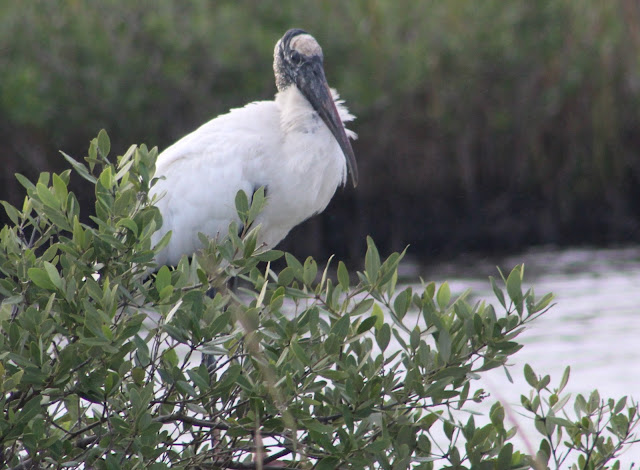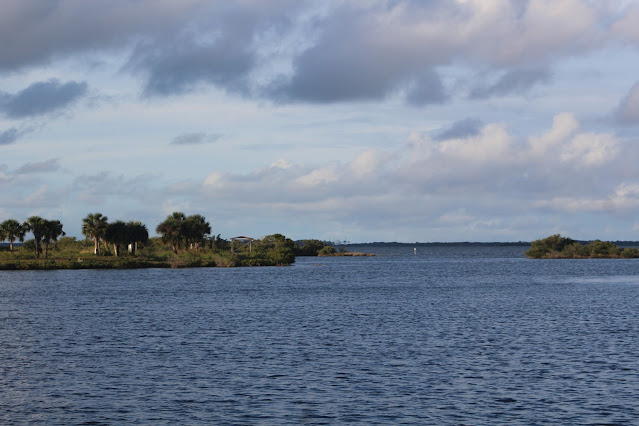On January 4th, Caleb and I headed north from Port St. Lucie for about 1.5 hours to bird the Atlantic Coast within the Merritt Island National Wildlife Refuge. This was a change in scenery for the trip, and was much different than our previous day of birding that was centered around exotics. I was excited to bird the coast, and it would be my first time birding the Atlantic Coast. In birding, I have a strong lack of oceanic birding and it's something I hope to participate in much more as I look ahead. The first look at something is always awesome, and it would be a day to learn lots of new things.

Our first stop was early, 7:40 A.M. at Canaveral National Seashore. We had our scopes and it didn't take us long to set up, and Alec Hopping came shortly after we got there and he birded with us for the rest of the day. Steady 12 m.p.h. winds came in from the northeast, something that Caleb mentioned would raise our chances of seeing stricter pelagic birds such as Great and Cory's Shearwaters. Birds were clearly abundant from the time we set our scopes on the water. As we were hoping for shearwaters, I was stoked enough when Caleb pointed out a Northern Gannet flying south. For me, this bird was a lifer, and one that is common off the Atlantic Coast. Adults, like the first one I saw, are a striking bright white with a cream-colored head and contrasting black wingtips. Gannets nest in large colonies on cliffs in the North Atlantic, and they spend most of their life at sea. They are commonly observed from shore as they fly through the ocean and forage for food. With Northern Gannets, it also takes a few years for them to reach adulthood. Juvenile birds are a sooty-brown color, and after we saw the adult, we saw a few young birds. Within minutes of our start this took place, but it turned out that the Gannet would be adundant for us. During our stationary seawatch, we tallied 443 Northern Gannets as single, small groups, and larger groups (up to 25 birds or so) would fly up and down the ocean adjacent to our scanning point.








Another huge highlight for me was my second life bird of the day and a seabird that I'd wanted to see for a long time, the Magnificent Frigatebird! These large birds are freaking cool with their long, pointed, forked tails and angular wings, and also with a dark and sinister appearance. Slow wingbeats and frequent soaring give off the large Frigatebird quickly, but they can switch things up too as they steal food from other seabirds with stunning acrobatic chases. Ever since I was a kid I thought the Frigatebird was cool because of it's red throat-pouch. Even though it wasn't inflated here away from it's breeding grounds, the red pouch was clearly visible on the male birds. The females were cool too and have white on their upper breast and a black throat rather than a red throat and black on the male. 13 Magnificent Frigatebirds were detected by us during the seawatch.





Aside from the two lifebirds of mine in Gannet and Frigatebird, it was awesome to watch an assortment of other birds along the Atlantic. 2 Surf Scoters and 30 Red-breasted Mergansers highlighted waterfowl. Shorebirds along the shore included Black-bellied Plover, Ruddy Turnstone, Sanderling, and Willet, and a few small flocks of Red Phalarope flew over the water. 5 Parasitic Jaegers were a highlight, as well as a single Pomarine Jaeger. Terns and Gulls were numerous too. 2 Bonaparte's Gull, 215 Laughing Gull, 24 Ring-billed Gull, 21 Herring Gull, 10 Lesser Black-backed Gull, and 3 Great Black-backed Gulls were the gulls we observed. The Great Black-backed was one I wanted to see again. Terns were represented by 6 Forster's Tern, 235 Royal Tern, 17 Sandwich Tern, and also ternlike, 3 Black Skimmers. A Red-throated Loon and 3 Common Loons added to the mix, as well as 2 Brown Boobies (who are uncommon along this stretch of the Atlantic). Brown Pelicans were abundant. This birding was stationary, and we stayed at one spot for 5.5 hours.
 |
| Sanderling |
 |
Brown Pelicans early
|
 |
| Osprey |
 |
Herring Gulls
|
 |
Ring-billed Gull
|
 |
Northern Gannets out at sea
|
 |
Sandwich Tern
|
 |
Royal Tern
|
 |
Laughing Gull
|
 |
Boat-tailed Grackle
|
 |
Great Black-backed Gull (above and below)
|
 |
Laughing Gulls and Royal Terns
|
 |
Royal Tern
|
 |
Laughing Gull
|
 |
Royal Tern flock with a Sandwich Tern and Laughing Gull
|
 |
Sandwich Tern
|
 |
Royal Terns
|
 |
Ruddy Turnstone (above and below)
|
 |
Sandwich Tern
|
On our way to get lunch, we stopped at a place called Parrish Park to look for a reported Long-tailed Duck. We weren't successful with the duck, but I had fun looking at some of the birds in the parking lot, including Fish Crows. The crows are slightly smaller than American Crows but look very similar, but their voice separates them easily. With Fish Crow, their "eh-uh" calls are pretty funny.
 |
Fish Crow
|
 |
Black Skimmer flock in the lot
|
 |
Ruddy Turnstone on dock
|
 |
Ruddy Turnstones, Laughing Gulls, Ring-billed Gull on dock
|
 |
Fish Crow
|
The rest of the day was spent within the Merrit Island National Wildlife Refuge. The Black Point Wildlife Drive was one of the cool routes that we drove within the refuge. We hiked a trail called the Cruickshank Trail, which took us through a variety of habitats out to a bay, and we saw an awesome variety of birds. 63 species were on the list. Aside from some of the regular birds I was already seeing throughout Florida, it was fun to see Mottled Duck, a Long-tailed Duck (which we struck out on earlier), and hearing a Clapper Rail (a species I've heard a few times but still haven't seen visually). We also had a stunning amount of Myrtle Yellow-rumped Warblers flying overhead; close to 500 birds!
 |
| Anhinga |
 |
Swamp Sparrow
|
 |
Anhinga in flight
|
 |
Reddish Egret (above and below)
|
 |
Wood Stork (above and below)
|
 |
Blue-winged Teal pair
|
 |
Roseate Spoonbill (above and below)
|
 |
White Ibis using the edges
|
 |
Long-tailed Duck (scarce in Florida)
|
 |
Mottled Ducks
|
 |
Great-blue Heron
|
 |
cool sunset over Merrit
|
Day 5 in Florida was a fun one. Thanks to Caleb and Alec for helping me get on lots of cool birds! I don't write nearly as much as I used to per post on this blog as I don't have as much time now, but hopefully photos will say it all.


































































No comments:
Post a Comment